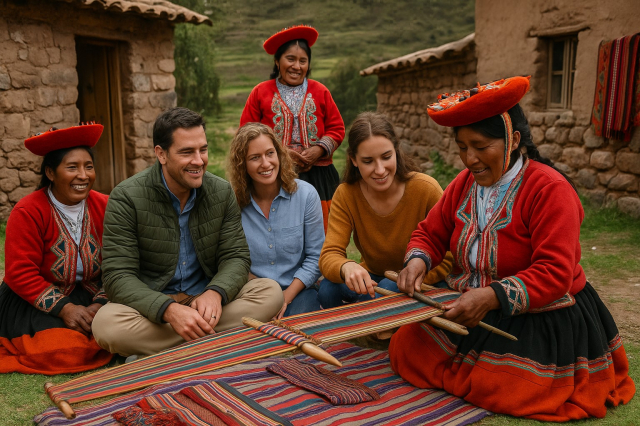What is community tourism and why is it growing in Peru?
Community-based tourism is a form of travel that allows visitors to live directly with local communities, participate in their daily activities, and contribute to the sustainable development of the area. In Peru, especially in the Andean highlands , this approach has become an opportunity to preserve traditional culture and generate equitable income for rural families.
Unlike conventional tourism, this isn't just about seeing landscapes or taking photos: it's about living the experience . Travelers share food, customs, and farm work, learning about Andean life from the inside.
Regions where community tourism is transforming the Peruvian highlands
1. Cusco and the Sacred Valley
Peru's tourist heartland is also a pioneer in community projects. In communities like Amaru , Chinchero, and Raqchi , visitors can participate in ancestral weaving workshops, learn about natural dyes, and sample dishes made with local products such as native potatoes or giant white corn.
These experiences combine living culture and sustainability , as the income is distributed between host families and community educational projects.
2. Puno and the islands of Lake Titicaca
The communities of Amantaní and Taquile are an example of community organization. Here, tourists stay overnight in family homes, learn about artisanal fishing, and participate in traditional dances on the shores of the world's highest navigable lake.
This model has been recognized for promoting responsible tourism and the preservation of Aymara and Quechua traditions .
3. Ayacucho and its artisan communities
In Vilcashuamán , Quinua , and surrounding villages, local families open their workshops to teach the making of ceramics, textiles, and Ayacucho-style altarpieces. Visitors can participate in the creative process and enjoy walks through nearby archaeological sites such as the Vilcashuamán complex or Intihuatana.
4. Ancash and the Callejón de Huaylas
Community-based tourism is also flourishing in the villages surrounding Huascarán National Park . Travelers can stay in communities like Vicos or Huasta , where they can enjoy hiking, organic potato farming, and shepherding activities. All of this takes place against a backdrop of imposing snow-capped peaks.
Benefits of community tourism for communities and travelers
The impact of community-based tourism goes far beyond the economic aspect. Among the main benefits are:
It strengthens the cultural identity of Andean communities.
It promotes economic equity by distributing income among local families.
It contributes to environmental conservation by promoting sustainable practices.
It offers visitors an authentic and educational experience , different from mass tourism.
It raises awareness about rural Peruvian life and the importance of cultural respect.
Furthermore, by staying in a rural or artisan community, you help reduce migration and preserve traditions that are part of Peru's cultural heritage.
Typical community tourism activities in the Peruvian highlands
Visitors can participate in various experiences, depending on the area:
| Activity | Recommended region | Description |
|---|---|---|
| Natural fabrics and dyes | Cusco (Amaru, Chinchero) | Workshops led by women weavers. |
| Artisanal fishing | Puno (Amantaní, Taquile) | Boat trips and preparation of local dishes. |
| Ceramic production | Ayacucho (Quinua) | Creation of pieces using ancestral techniques. |
| Organic farming | Ancash (Vicos) | Plant and harvest using sustainable practices. |
| Cultural walks | Apurímac and Huancavelica | Routes with community guides and local legends. |
How to practice community tourism responsibly
If you plan to have this experience, follow these recommendations to do so ethically and sustainably:
Hire communities directly. Avoid intermediaries who don't bring local benefits.
Respect community customs and norms. Ask before taking photographs or participating in ceremonies.
Buy local products. Support the rural economy and reduce your environmental impact.
Reduce your use of plastics and leave places clean.
Participate with an open mind. Community tourism is a cultural exchange, not just a visit.
Highlighted experiences of travelers in Andean communities
Many domestic and international travelers agree that the most valuable aspect of community-based tourism in the Peruvian highlands is the human connection . Sleeping in a communal house, sharing a pachamanca, or listening to stories from elders around the hearth transforms one's understanding of travel.
These experiences create authentic memories and help the visitor feel part of the community , even if only for a few days.
The future of community tourism in Peru
Community-based tourism has great growth potential. With the support of initiatives from the Ministry of Foreign Trade and Tourism (MINCETUR) and regional organizations, community members are receiving enhanced training in hospitality, marketing, and sustainability.
The current trend points towards a more inclusive, ethical and responsible tourism, where the visitor seeks to live real experiences instead of simple tourist tours.
As more Peruvians discover these alternatives, the highlands are consolidating themselves as an ideal destination for experiential tourism and cultural learning .
